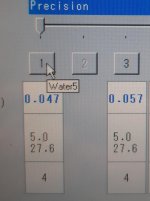nlancaster
Aluminum
- Joined
- Oct 8, 2018
So, for the last few years I have been doing most of the programing for our 2 Sodick AG600L machines.
I have always had to adjust the hole size with extra offsets usually negative amounts to make the hole larger.
Example:
Bore starts as a .140 precision bored hole, with less then .0005 runout to the OD of the part.
I use conditions for open cuts as the bore is large so do not get a good seal.
Program a .1503+/-.0002 hole and the initial size will be .148ish.
Slots on the OD of the same part with the same offsets will be within .0005 of nominal, .035
Then I have to make adjustments with FLAG7D, a global offset adjustment for the hole, of -.0015ish varies program to program.
Anyone have any experience on why this may be happening?
I have always had to adjust the hole size with extra offsets usually negative amounts to make the hole larger.
Example:
Bore starts as a .140 precision bored hole, with less then .0005 runout to the OD of the part.
I use conditions for open cuts as the bore is large so do not get a good seal.
Program a .1503+/-.0002 hole and the initial size will be .148ish.
Slots on the OD of the same part with the same offsets will be within .0005 of nominal, .035
Then I have to make adjustments with FLAG7D, a global offset adjustment for the hole, of -.0015ish varies program to program.
Anyone have any experience on why this may be happening?





